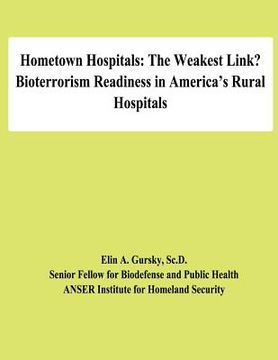Hometown Hospitals: The Weakest Link? Bioterrorism Readiness in America's Rural Hospitals (in English)
Synopsis "Hometown Hospitals: The Weakest Link? Bioterrorism Readiness in America's Rural Hospitals (in English)"
Over the past decade, acts of international and domestic terrorism have demonstrated to government officials and policy makers the urgency of preparing systems to support the detection of atypical health events and the provision of preventive and interventional medical services in mass-care events. The 1995 bombing of the Alfred P. Murrah Federal Building in Oklahoma City resulted in 168 deaths and required the efforts of nearly 5,500 emergency responders dispatched to the scene over 17 days in chaotic and feverish attempts to rescue and facilitate subsequent medical and surgical interventions to save the lives of over 600 injured victims. The September 11, 2001, attacks on the World Trade Center and the Pentagon resulted in over 3,000 deaths and nearly 2,400 injured. The lethality of the attacks averted strain on hospitals but, once again, required the coordinated efforts of emergency responders and medical providers. The anthrax attacks of 2001 resulted in relatively few victims. On March 11, 2004, terrorist bombings on several trains in Madrid resulted in nearly 200 deaths and about 1,800 injured.5 Madrid's hospitals were swamped with casualties as the hospitals appealed urgently for blood donations. Acts of terrorism upon civilian populations necessitate a robust response by health and medical care systems and present particular challenges to the United States' almost 5,000 acute care hospitals. As the locus of medical diagnosis and intervention for a wide array of routine activities ranging from the provision of primary care for the uninsured to the delivery of tertiary procedures for life-threatening diseases, hospitals face the quandary of terrorism preparedness and response with limited budgets and insufficient numbers of trained human resources. These needs are even more acutely experienced by the nation's approximately 2,000 rural hospitals, which have a comparatively smaller repertoire of medical resources yet face unique vulnerabilities. The spectrum of weapons of mass destruction demands a diverse set of response capabilities. The use of an explosive device necessitates an urgent and massive medical effort to save the lives of injured persons not immediately killed. Conversely, the deployment of a biological agent in most instances unleashes a communicable pathogen, the required response to which grows greater over time as the incidence of human infection increases. The resulting epidemic is workforce consuming, requiring voluminous amounts of human resources and medical equipment to interrupt disease transmission and reduce rates of mortality through disease tracking and monitoring, verification of exposure, administration of medical countermeasures where available (for example, vaccines and preventive antibiotics), and supportive care and clinical treatment. The case studies described herein offer a view of the challenges facing rural hospitals to meet these demands as they prepare for the threat of bioterrorism as well as non-intentional, naturally occurring epidemics of emerging contagious diseases such as severe acute respiratory syndrome (SARS). The findings are sobering and include a pervasive perception among study participants that major medical emergencies in America's rural areas and heartland would quickly overwhelm the capabilities of their small hospitals. A catastrophic event, or an act of bioterrorism, will require that rural hospitals receive outside assistance to sustain ongoing operations, intervene in the potentially unremitting flow of medical emergencies, and contain the epidemic sequelae of a deliberately deployed pathogen. The delivery of medical care to infected populations and the containment of disease epidemics require that hospitals occupy a central role in community-based bioterrorism preparedness planning. The author provides this report to inform future initiatives to prepare America's hospitals against threats to homeland security.

